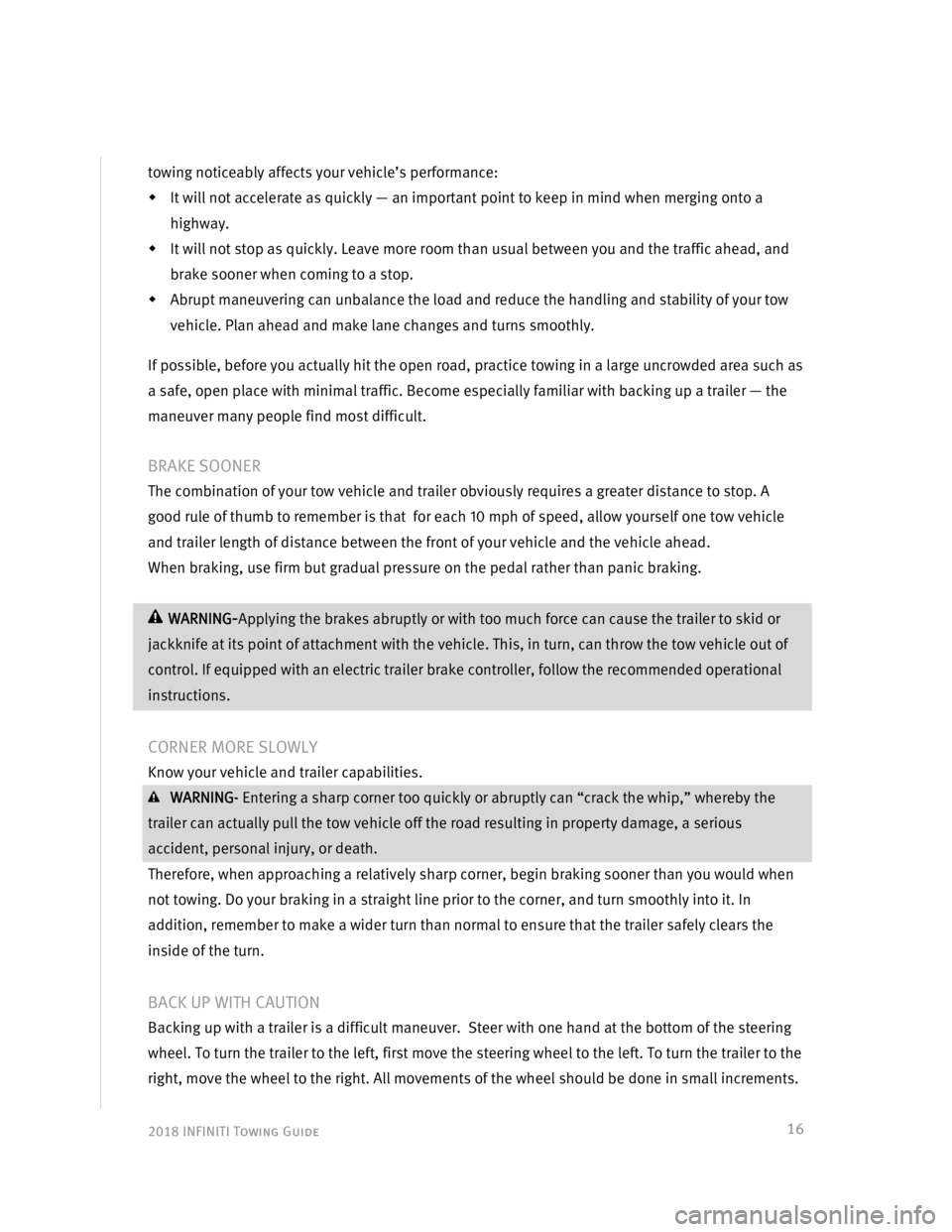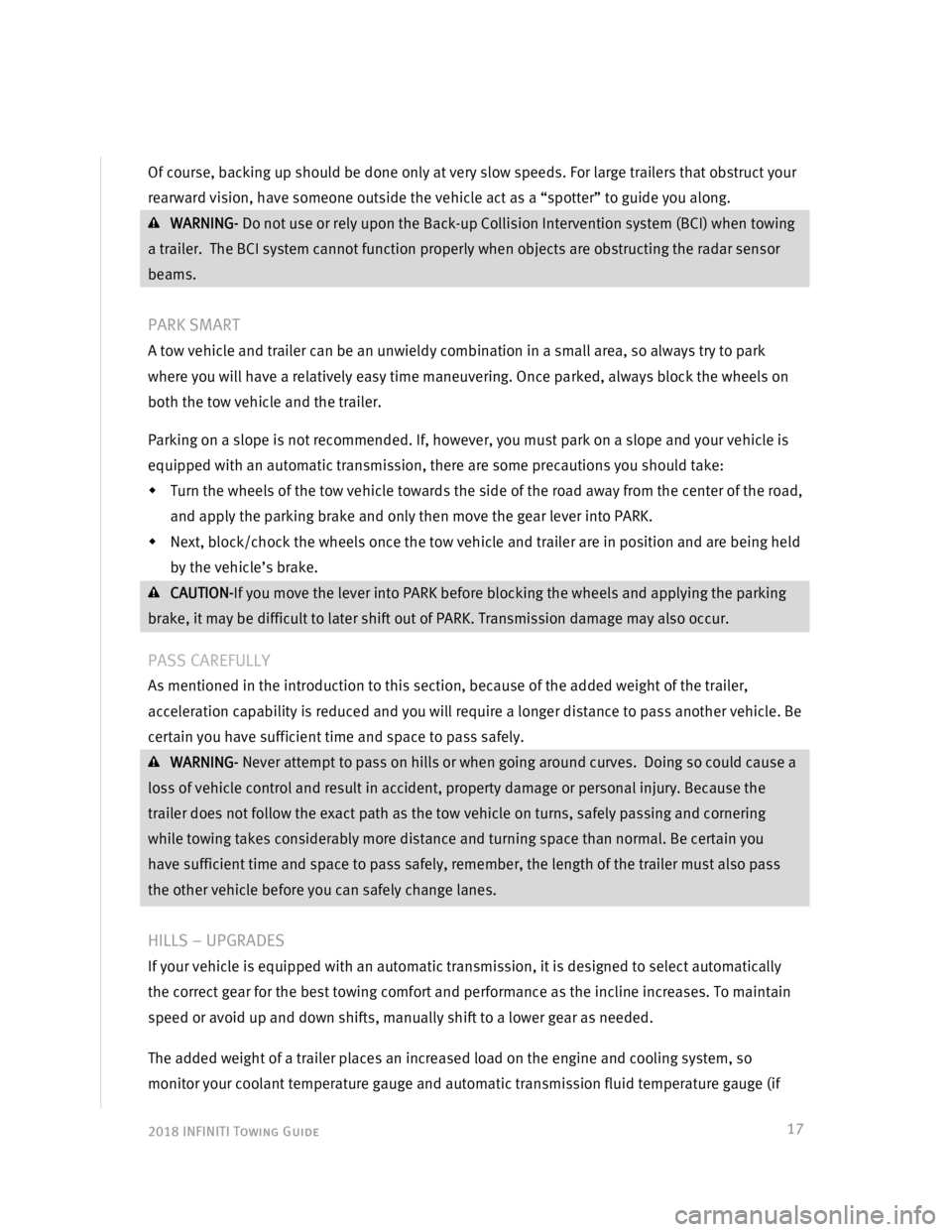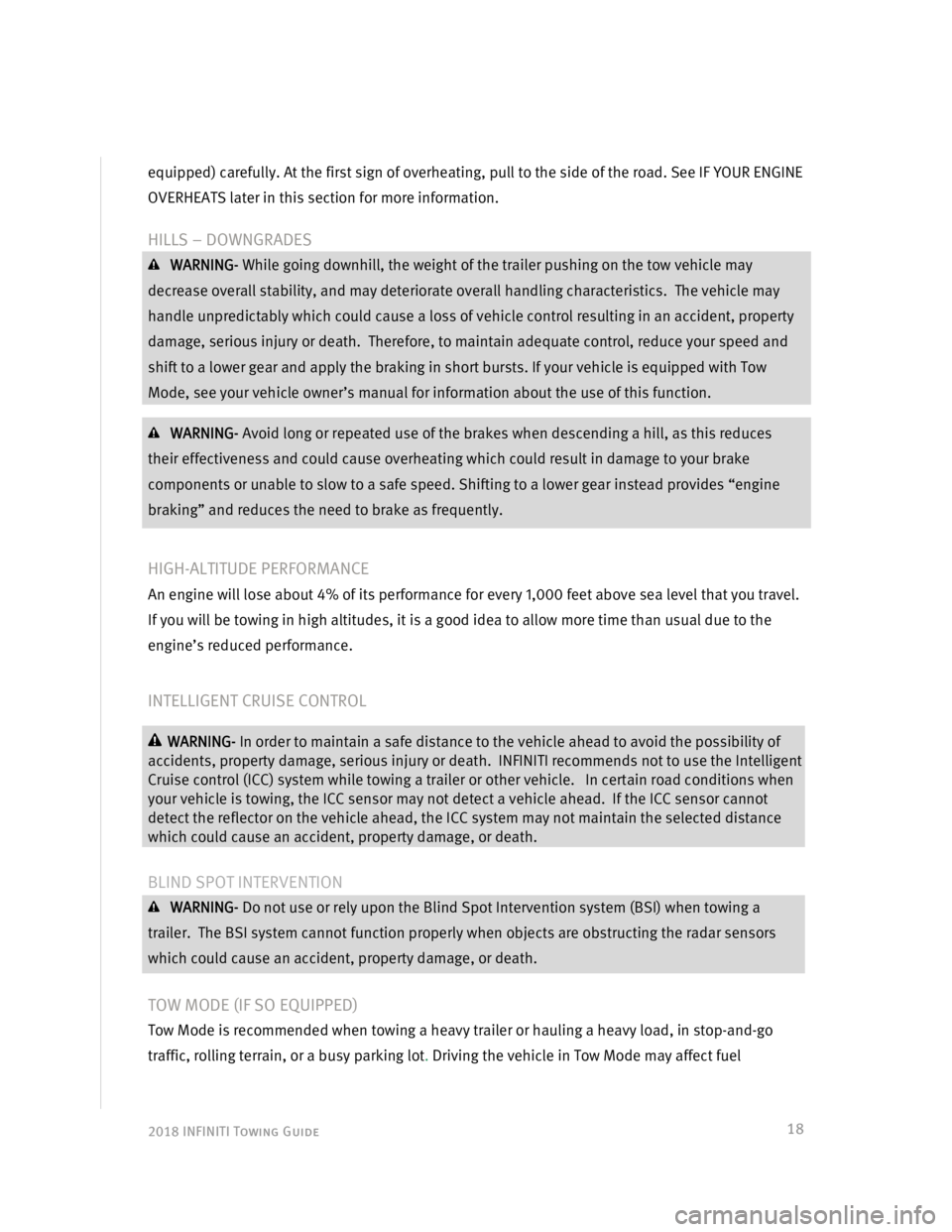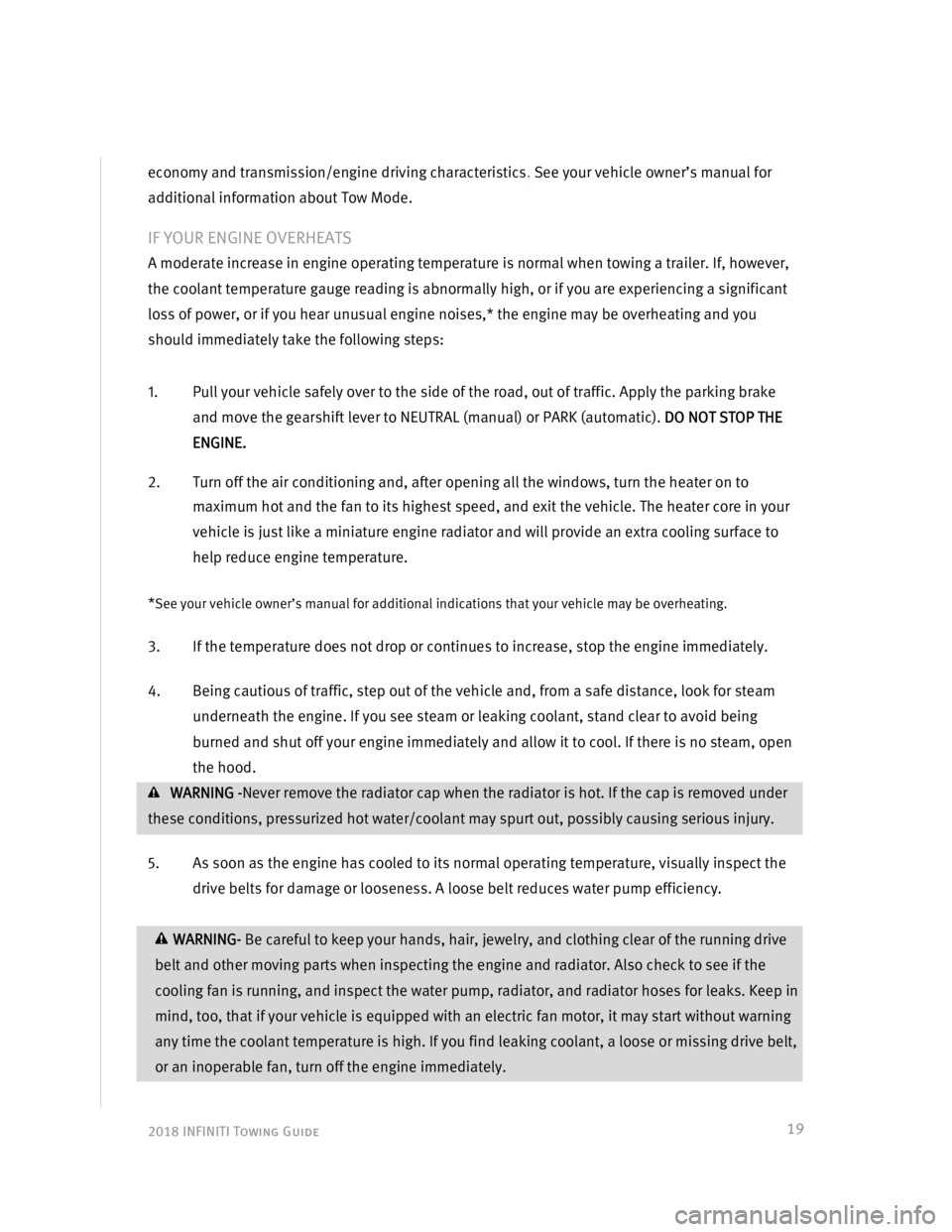warning INFINITI Q70 HYBRID 2018 Towing Guide
[x] Cancel search | Manufacturer: INFINITI, Model Year: 2018, Model line: Q70 HYBRID, Model: INFINITI Q70 HYBRID 2018Pages: 25, PDF Size: 0.29 MB
Page 17 of 25

2018 INFINITI Towing Guide
16
towing noticeably affects your vehicle’s performance:
It will not accelerate as quickly — an important point to keep in mind when merging onto a
highway.
It will not stop as quickly. Leave more room than usual between you and the traffic ahead, and
brake sooner when coming to a stop.
Abrupt maneuvering can unbalance the load and reduce the handling and stability of your tow
vehicle. Plan ahead and make lane changes and turns smoothly.
If possible, before you actually hit the open road, practice towing in a large uncrowded area such as
a safe, open place with minimal traffic. Become especially familiar with backing up a trailer — the
maneuver many people find most difficult.
BRAKE SOONER
The combination of your tow vehicle and trailer obviously requires a greater distance to stop. A
good rule of thumb to remember is that for each 10 mph of speed, allow yourself one tow vehicle
and trailer length of distance between the front of your vehicle and the vehicle ahead.
When braking, use firm but gradual pressure on the pedal rather than panic braking.
WARNING-Applying the brakes abruptly or with too much force can cause the trailer to skid or
jackknife at its point of attachment with the vehicle. This, in turn, can throw the tow vehicle out of
control. If equipped with an electric trailer brake controller, follow the recommended operational
instructions.
CORNER MORE SLOWLY
Know your vehicle and trailer capabilities.
WARNING- Entering a sharp corner too quickly or abruptly can “crack the whip,” whereby the
trailer can actually pull the tow vehicle off the road resulting in property damage, a serious
accident, personal injury, or death.
Therefore, when approaching a relatively sharp corner, begin braking sooner than you would when
not towing. Do your braking in a straight line prior to the corner, and turn smoothly into it. In
addition, remember to make a wider turn than normal to ensure that the trailer safely clears the
inside of the turn.
BACK UP WITH CAUTION
Backing up with a trailer is a difficult maneuver. Steer with one hand at the bottom of the steering
wheel. To turn the trailer to the left, first move the steering wheel to the left. To turn the trailer to the
right, move the wheel to the right. All movements of the wheel should be done in small increments.
Page 18 of 25

2018 INFINITI Towing Guide
17
Of course, backing up should be done only at very slow speeds. For large trailers that obstruct your
rearward vision, have someone outside the vehicle act as a “spotter” to guide you along.
WARNING- Do not use or rely upon the Back-up Collision Intervention system (BCI) when towing
a trailer. The BCI system cannot function properly when objects are obstructing the radar sensor
beams.
PARK SMART
A tow vehicle and trailer can be an unwieldy combination in a small area, so always try to park
where you will have a relatively easy time maneuvering. Once parked, always block the wheels on
both the tow vehicle and the trailer.
Parking on a slope is not recommended. If, however, you must park on a slope and your vehicle is
equipped with an automatic transmission, there are some precautions you should take:
Turn the wheels of the tow vehicle towards the side of the road away from the center of the road,
and apply the parking brake and only then move the gear lever into PARK.
Next, block/chock the wheels once the tow vehicle and trailer are in position and are being held
by the vehicle’s brake.
CAUTION-If you move the lever into PARK before blocking the wheels and applying the parking
brake, it may be difficult to later shift out of PARK. Transmission damage may also occur.
PASS CAREFULLY
As mentioned in the introduction to this section, because of the added weight of the trailer,
acceleration capability is reduced and you will require a longer distance to pass another vehicle. Be
certain you have sufficient time and space to pass safely.
WARNING- Never attempt to pass on hills or when going around curves. Doing so could cause a
loss of vehicle control and result in accident, property damage or personal injury. Because the
trailer does not follow the exact path as the tow vehicle on turns, safely passing and cornering
while towing takes considerably more distance and turning space than normal. Be certain you
have sufficient time and space to pass safely, remember, the length of the trailer must also pass
the other vehicle before you can safely change lanes.
HILLS – UPGRADES
If your vehicle is equipped with an automatic transmission, it is designed to select automatically
the correct gear for the best towing comfort and performance as the incline increases. To maintain
speed or avoid up and down shifts, manually shift to a lower gear as needed.
The added weight of a trailer places an increased load on the engine and cooling system, so
monitor your coolant temperature gauge and automatic transmission fluid temperature gauge (if
Page 19 of 25

2018 INFINITI Towing Guide
18
equipped) carefully. At the first sign of overheating, pull to the side of the road. See IF YOUR ENGINE
OVERHEATS later in this section for more information.
HILLS – DOWNGRADES
WARNING- While going downhill, the weight of the trailer pushing on the tow vehicle may
decrease overall stability, and may deteriorate overall handling characteristics. The vehicle may
handle unpredictably which could cause a loss of vehicle control resulting in an accident, property
damage, serious injury or death. Therefore, to maintain adequate control, reduce your speed and
shift to a lower gear and apply the braking in short bursts. If your vehicle is equipped with Tow
Mode, see your vehicle owner’s manual for information about the use of this function.
WARNING- Avoid long or repeated use of the brakes when descending a hill, as this reduces
their effectiveness and could cause overheating which could result in damage to your brake
components or unable to slow to a safe speed. Shifting to a lower gear instead provides “engine
braking” and reduces the need to brake as frequently.
HIGH-ALTITUDE PERFORMANCE
An engine will lose about 4% of its performance for every 1,000 feet above sea level that you travel.
If you will be towing in high altitudes, it is a good idea to allow more time than usual due to the
engine’s reduced performance.
INTELLIGENT CRUISE CONTROL
WARNING- In order to maintain a safe distance to the vehicle ahead to avoid the possibility of
accidents, property damage, serious injury or death. INFINITI recommends not to use the Intelligent
Cruise control (ICC) system while towing a trailer or other vehicle. In certain road conditions when
your vehicle is towing, the ICC sensor may not detect a vehicle ahead. If the ICC sensor cannot
detect the reflector on the vehicle ahead, the ICC system may not maintain the selected distance
which could cause an accident, property damage, or death.
BLIND SPOT INTERVENTION
WARNING- Do not use or rely upon the Blind Spot Intervention system (BSI) when towing a
trailer. The BSI system cannot function properly when objects are obstructing the radar sensors
which could cause an accident, property damage, or death.
TOW MODE (IF SO EQUIPPED)
Tow Mode is recommended when towing a heavy trailer or hauling a heavy load, in stop-and-go
traffic, rolling terrain, or a busy parking lot. Driving the vehicle in Tow Mode may affect fuel
Page 20 of 25

2018 INFINITI Towing Guide
19
economy and transmission/engine driving characteristics. See your vehicle owner’s manual for
additional information about Tow Mode.
IF YOUR ENGINE OVERHEATS
A moderate increase in engine operating temperature is normal when towing a trailer. If, however,
the coolant temperature gauge reading is abnormally high, or if you are experiencing a significant
loss of power, or if you hear unusual engine noises,* the engine may be overheating and you
should immediately take the following steps:
1. Pull your vehicle safely over to the side of the road, out of traffic. Apply the parking brake
and move the gearshift lever to NEUTRAL (manual) or PARK (automatic). DO NOT STOP THE
ENGINE.
2. Turn off the air conditioning and, after opening all the windows, turn the heater on to
maximum hot and the fan to its highest speed, and exit the vehicle. The heater core in your
vehicle is just like a miniature engine radiator and will provide an extra cooling surface to
help reduce engine temperature.
*
See your vehicle owner’s manual for additional indications that your vehicle may be overheating.
3.
If the temperature does not drop or continues to increase, stop the engine immediately.
4. Being cautious of traffic, step out of the vehicle and, from a safe distance, look for steam
underneath the engine. If you see steam or leaking coolant, stand clear to avoid being
burned and shut off your engine immediately and allow it to cool. If there is no steam, open
the hood.
WARNING -Never remove the radiator cap when the radiator is hot. If the cap is removed under
these conditions, pressurized hot water/coolant may spurt out, possibly causing serious injury.
5. As soon as the engine has cooled to its normal operating temperature, visually inspect the
drive belts for damage or looseness. A loose belt reduces water pump efficiency.
WARNING- Be careful to keep your hands, hair, jewelry, and clothing clear of the running drive
belt and other moving parts when inspecting the engine and radiator. Also check to see if the
cooling fan is running, and inspect the water pump, radiator, and radiator hoses for leaks. Keep in
mind, too, that if your vehicle is equipped with an electric fan motor, it may start without warning
any time the coolant temperature is high. If you find leaking coolant, a loose or missing drive belt,
or an inoperable fan, turn off the engine immediately.